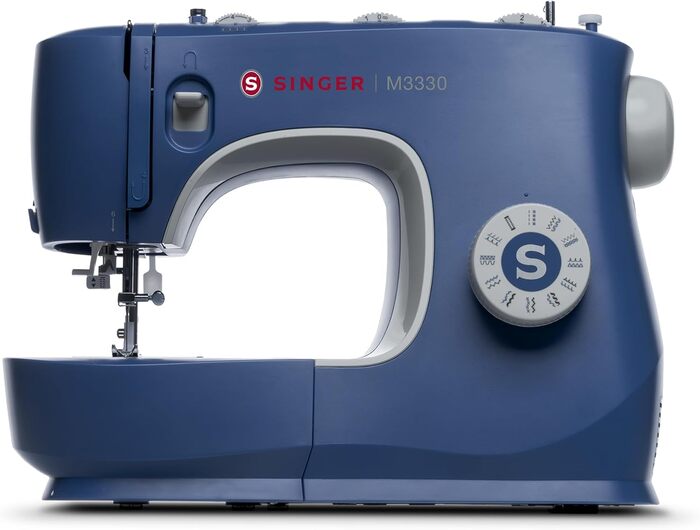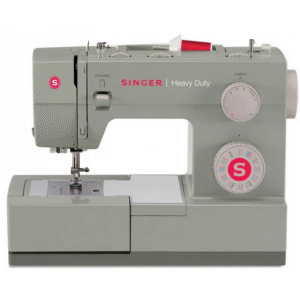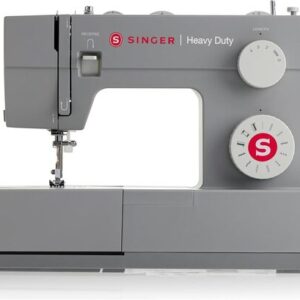I still remember the morning the blue-and-white box showed up at my door. For weeks I’d been reading Singer M3300 reviews and watching setup videos at 2 a.m., trying to decide if this little workhorse could be my “get-back-into-sewing” machine. My grandma’s old tank was long gone, and I didn’t want bells and whistles — I wanted something light, friendly, and ready to mend a hem without a tantrum.
Unboxing jitters, beginner hopes
Out of the box, the Singer M3300 looked cheerful, not intimidating. It’s lightweight with a sturdy handle, so I carried it from the hallway to the kitchen table like a lunchbox. Inside the accessory tray were the basics — needles, bobbins, feet I actually recognized — and a quick-start card. No printed manual though. Classic. I pulled up the PDF on my tablet and kept it propped against a mug.
First date with the thread path
Threading made me nervous because it had been years, but the path is numbered and the diagrams are clear. I tried the automatic needle threader first. It worked… exactly once. Then it acted shy and wouldn’t catch the eye of the needle again. After three polite attempts and one deep sigh, I threaded it by hand and moved on. (From what I’d seen in the Singer M3300 sewing machine reviews, I half-expected this. Not a dealbreaker, just mildly annoying.)
The bobbin is front-loading, which means slowing down for a second to learn the rhythm: wind it evenly, click it in, thread it around the little metal hook — close, hold the tails, and turn the handwheel to catch. The first time I got a bird’s nest of thread under the plate. I re-read the steps, lifted the presser foot before threading (key!), and it behaved.
That first line of stitches
For a warm-up I grabbed a pillowcase with a split seam. I lowered the needle, breathed, and pressed the pedal. The Singer M3300 sewing machine didn’t screech or rattle; it hummed. The straight stitch looked neat, the fabric fed evenly, and the speed felt beginner-friendly — slow when I needed it, faster when I relaxed. I fixed the pillowcase and immediately hemmed two pairs of jeans. Over the thick denim corner it hesitated, then climbed the “speed bump” and kept going. Three layers were fine; four needed patience and a bigger needle (90/14). Anything beyond that, I’d plan a gentler route or a different machine. Honest expectations = happy sewing.
The small lessons that made a big difference
Day two was bobbin drama day. I got overconfident and used bargain thread. Instant tangles. I switched to better thread, re-wound the bobbin so it was firm and even, and added a tiny drop of oil around the bobbin case. Boom — smooth again. Lint can make this model chatty, so I keep a little brush in the tray and clean under the plate every couple of projects. When it starts to clack, a quick clean solves it.
I also learned to park a pair of tweezers in the tray. Front-loaders sometimes ask for a steady hand to fish out an extra tail or two. The more I practiced, the less I needed them.
Real projects, real confidence
Once we were on speaking terms, I got braver. A canvas tote with a boxed bottom? Done. A soft flannel baby blanket with a zigzag edge? Sweet and tidy. A table runner using one of the decorative stitches? So cute. The one-step buttonhole surprised me — it’s simple and makes me look more skilled than I am. The LED light is bright enough that I don’t squint, and even though the body is mostly plastic, you can feel the solid metal frame underneath when it’s stitching along.
Noise-wise, my unit “purrs with opinions.” It’s not silent, but I can sew at night without waking the house. On the days it gets loud, I’ve always found fluff in the bobbin area or a nicked needle I should have changed ages ago.
Teaching moment
My niece came over to make a simple drawstring backpack. She’d never touched a sewing machine. We watched one short video together, and she threaded it on her second try. The speed control and steady feed made it easy to let her steer while I hovered like a nervous driving instructor. When she pulled the backpack on her shoulders, she did a victory lap around the living room. If you’re scanning Singer M3300 sewing machine reviews to find a friendly first machine for a teen, this is exactly the vibe.
Where the M3300 shines — and where it doesn’t
Shines: everyday mending, hemming, basic garments, simple crafts, and lightweight quilting. It’s portable, easy to store, and not fussy about switching stitches. The stitch selection is more than enough for daily life — straight, zigzag, a few fun accents, and that handy buttonhole. It’s also kind to beginners; the controls are straightforward, and there are tons of videos that match this exact model.
Doesn’t: if your plan is heavy canvas, thick vinyl, or six layers of denim every weekend, the M3300 will ask for breaks. It’s honest about its size and power. And yes, the auto-threader is hit-or-miss. I consider it a bonus when it behaves and use my eyes and tweezers when it doesn’t. Also, be ready to live with the online manual. I ended up printing the pages I use most and slipping them into a clear folder.
Six weeks in: the rhythm of routine
With a little routine — dusting, new needles, decent thread, and the occasional drop of oil — the machine stays dependable. I’ve repaired a jacket pocket, finished a quilted potholder set, and finally resized a thrift-store dress that sat in my closet for a year. My favorite part is how quick it is to set up: plug in, pop a bobbin, thread, and sew. The whole “what if it jams?” anxiety has been replaced by “what can I make next?”
My plain-language verdict
If you’re deep in Singer M3300 reviews trying to decide, here’s my simple, human take: the Singer M3300 sewing machine is a lightweight, portable buddy for everyday sewing. It’s beginner-friendly, budget-sensible, and surprisingly steady for its size. Keep your expectations realistic about heavy layers, use good thread and fresh needles, and learn the bobbin routine, and you’ll be happy.
Is it perfect? No. The auto threader can be moody, some folks (me included) wish for a printed manual, and a little maintenance goes a long way. But as a daily driver — the kind of machine that helps you hem, fix, craft, and learn — it earns its spot on my table.
If you’re browsing Singer M3300 sewing machine reviews wondering whether this model is hype or help, I’ll put it this way: it turned my “I should really mend that” pile into a “done and dusted” basket. And that, to me, is the best review a sewing machine can get.
Singer M3300: Pros & Cons from Customer Feedback
| Pros | Cons |
|---|---|
| Easy to set up and thread with help from YouTube; beginner-friendly. | Frequent bobbin issues: jamming, bird’s nests, or misalignment. |
| Lightweight and portable; built-in handle makes it easy to store and carry. | Automatic needle threader often unreliable or arrives misaligned/broken. |
| Good variety of stitches (incl. one-step buttonhole) for everyday projects. | No printed manual in the box; PDF only and sometimes hard to find/wrong language. |
| Feels stable for its size; metal frame under the plastic housing. | Some units are noisy (“clacky”/“machine-gun” loud) or bang while sewing. |
| Delivers neat stitches for alterations, hemming, basic repairs, and simple crafts. | Quality-control complaints: DOA units, stuck handwheel, timing out of sync. |
| Can handle light denim seams and a few fabric layers when properly set up. | Not ideal for very thick fabrics or more than 3–4 layers; limited power. |
| Good value/price for learners and casual sewers. | Customer service/returns can be frustrating (third-party sellers, weekend closures). |
| Many owners say it runs smoothly/quietly after basic cleaning and a drop of oil. | Thread tension problems for some right out of the box; occasional pro repair needed. |
| Attractive, compact design; color gets compliments. | Missing or incorrect parts reported (oil bottle, plug type, accessories; EU cord in US). |
| Works well as a first machine or gift for teens and beginners. | Front-loading bobbin can be tricky for newcomers; steeper learning curve than drop-in. |
| Clear diagrams online; video tutorials make learning easier. | No storage case included; controls/dials not well explained for true beginners. |
| Long-time Singer users appreciate the familiar feel and straightforward basics. | Durability concerns from a minority (breakdowns within weeks/months; slower than older all-metal models). |
If you want a simple, portable daily driver for alterations and small projects, the Singer M3300 sewing machine can be a friendly fit — especially if you’re okay using video guides and good-quality thread/needles. If you need heavy-fabric power, a rock-solid auto-threader, or a printed manual, the mixed Singer M3300 reviews suggest considering a higher-tier model.
Singer M3300 — Your Most-Asked Questions Answered
What is the Singer M3300 and who is it best for?
The Singer M3300 is a lightweight, portable household sewing machine made for everyday mending, simple garments, crafts, and learner projects. If you want a friendly, no-fuss machine that covers core stitches and a 1-step buttonhole, this model fits well. Many Singer M3300 reviews say it’s a solid starter when paired with good thread and fresh needles.
Which stitches and buttonholes does the Singer M3300 have?
You select stitches with the Pattern Selector Dial; set stitch length and width with their dials. The M3300 offers utility, stretch (via S1/S2), decorative options, and a 1-step buttonhole using the dedicated buttonhole foot and lever. Width adjusts 0–5 mm. Always test on a fabric scrap first.
How do I wind and insert the bobbin on the Singer M3300?
Place thread on the spool pin with holder, route through the bobbin-winder guide, wind on the bobbin and push the spindle right to wind; return it left to sew. Insert the bobbin into the front-load bobbin case so thread runs clockwise, pull through the slot and under the tension spring, then latch the case into the shuttle. Needle must be raised when inserting or removing.
How do I thread the upper path and use the automatic needle threader?
Raise the presser foot, turn the handwheel to raise the needle fully, follow the numbered guides down-right and up-left through the take-up lever, then down to the needle (front to back). For the auto threader: raise needle, hook the thread in the guide, press the lever down, loop the thread under the hook, and release to pull a loop through the eye. Power should be off during threading.
How do I bring up the bobbin thread?
Hold the upper thread tail, turn the handwheel toward you to lower then raise the needle, and gently pull the upper thread to lift the bobbin loop through the needle plate. Lay both tails under the foot toward the back before sewing.
What are the basic tension settings on the Singer M3300?
The typical upper-thread setting is around 4, with most sewing between 3 and 5. For straight stitch, aim for balanced top/bottom tension; for zigzag/decoratives, use slightly less upper tension so a bit of top thread shows underneath to reduce puckering. Bobbin tension is factory-set.
How do stitch length and width work on this machine?
Turn the Stitch Length Dial toward 0 for short stitches and toward 4 for longer ones. On zigzag, moving toward 0 makes a dense satin stitch. The Stitch Width Dial sets zigzag width up to 5 mm and also shifts straight-stitch needle position. Test settings on a scrap before your project.
How do I lock seams, remove projects, and cut threads?
Press and hold the Reverse Lever to back-tack at the start and end. To remove your work, turn the handwheel until the take-up lever is up, lift the presser foot, and pull fabric back. Use the built-in thread cutter at the side to trim tails.
Can the Singer M3300 handle stretch hems, zippers, buttons, and piping?
Yes. Use stretch stitches via S1/S2 for knits, blind-hem settings for invisible hems, the zipper foot for zippers and piping, and the button-sewing foot with the darning plate to stitch buttons in place. Always test width/length and foot selection on a scrap first.
Which needles and threads should I use?
Match needle size and type to fabric and thread: light fabrics use 70/9–80/11; medium 80/12–90/14; heavy 100/16–110/18. Use sharp (2020) for wovens, ballpoint (2045) for knits, and leather (2032) for leather/vinyl. Use similar weight thread top and bobbin for best results.
What presser feet and accessories come with the Singer M3300?
Standard: all-purpose foot, zipper foot, 1-step buttonhole foot, button-sewing foot, L-screwdriver, seam ripper/brush, needles, four Class-15 bobbins, edge/quilting guide, darning plate, spool holder, and a soft cover. An extension table is also the removable accessory box. Optional feet are available from Singer.
How do I sew thicker layers on the Singer M3300?
Use the two-step presser-foot lifter to raise the foot higher for positioning bulky items, choose the right needle (e.g., 90/14 for denim), lengthen stitch slightly, and sew slowly over seam ‘humps’. The machine is for household use; avoid forcing more than a few layers.
How do I clean, oil, and maintain the machine?
Unplug first. Remove the needle plate and brush out lint from feed teeth. Take out the bobbin case, open the two hook-retaining arms, remove the hook and race cover, wipe clean, then apply 1–2 drops of sewing-machine oil at the hook point. Reassemble and re-thread. Service the machine at intervals for best results.
How do I fix common issues like jamming, thread breaks, or noise?
For upper thread breaks, re-thread with presser foot up, lower tension, or change a damaged needle. For bobbin breaks or nests, re-insert and thread the bobbin case correctly. If stitches skip, check needle type/size and foot. If noisy, clean lint from hook/feed teeth and replace a dull or bent needle. The manual’s troubleshooting chart walks through exact causes and fixes.
What safety and power tips should I know?
Never leave the machine plugged in unattended; always unplug before cleaning or changing needles/feet. Keep fingers away from moving parts, use proper needle plates, and do not sew with bent needles. Use only the specified foot controls for your region and a polarized outlet; normal operating noise is under 75 dB(A). The Singer M3300 is double-insulated.
Where can I find the manual and quick help?
The model ships with a quick guide and a PDF manual online. If you prefer a printed reference, print the key pages you use most (threading, bobbin, buttonhole, maintenance). Many Singer M3300 sewing machine reviews also point to helpful setup videos for the exact model.
What do real users say in Singer M3300 reviews?
From the reviews above: people like how easy it is to set up, the portability, and clean stitches for basic projects. Common tips include using quality thread, changing needles often, and cleaning the bobbin area to prevent jamming. Some users note the auto needle threader can be finicky and prefer the online manual. These patterns align with most Singer M3300 sewing machine reviews and mirror the manual’s guidance on setup and care.
| Spec | Details |
|---|---|
| Model / Type | Singer M3300 sewing machine — household, mechanical (dial-based). |
| Compliance & Safety | Designed to comply with IEC/EN 60335-2-28 and UL1594; double-insulated appliance; polarized plug; do not use outdoors. |
| Noise Level | < 75 dB(A) under normal operating conditions. |
| Stitch Selection | Pattern Selector Dial with utility, decorative, and stretch stitches (via S1/S2 on the Stitch Length Dial). |
| Buttonhole | 1-Step automatic buttonhole (M3300). Use the buttonhole foot and buttonhole lever. |
| Max Zigzag Width | Up to 5 mm (adjustable 0–5 mm). |
| Stitch Length Range | Approx. 0–4; denser zigzag as dial approaches 0 (satin-style density). |
| Needle Position (Straight Stitch) | Infinitely adjustable via Stitch Width Dial (0 = center; 5 = full left for M3300). |
| Thread Tension | Upper tension nominal “4” (typical range 3–5); bobbin tension factory-set. |
| Bobbin System | Front-load bobbin case; uses SINGER Class 15 bobbins (4 included). |
| Threading | Numbered upper-thread path with automatic needle threader (power off while threading). |
| Presser-Foot Lift | Two-step presser-foot lifter for extra clearance when positioning thick fabrics. |
| Reverse / Thread Cutting | Reverse lever for back-tacking; built-in side thread cutter. |
| Lighting | Integrated LED sewing light (service/replace by qualified personnel if damaged). |
| Feed System | Standard feed dogs; includes darning plate to cover feed for free-motion/darning. |
| Accessory Storage | Removable extension table doubles as accessory box. |
| Included Accessories | All-purpose foot, zipper foot, 1-step buttonhole foot, button-sewing foot, L-screwdriver, seam ripper/brush, needle pack, 4× Class-15 bobbins, edge/quilting guide, darning plate, spool holder, soft cover. |
| Needle & Fabric Guide | Use SINGER needles: 2020 (wovens), 2045 (ballpoint/knits), 2032 (leather); sizes 70/9–110/18 matched to fabric/thread weight. |
| Power & Controls | Power/light rocker switch; variable-speed foot control pedal. |
| Approved Foot Controls (by region) | CENELEC (220–240V): FC-2902D, 4C-326G (230V), 4C-336G (240V). Non-CENELEC: KD-1902/FC-1902 (110–120V); KD-2902/FC-2902A/C/D (220–240V); 4C-316B (110–125V), 4C-316C (127V), 4C-326C (220V), 4C-326G (230V), 4C-336G (240V). |
| Maintenance | Regular lint cleaning under plate and around hook; lubricate hook race with 1–2 drops of sewing-machine oil; service periodically. |





